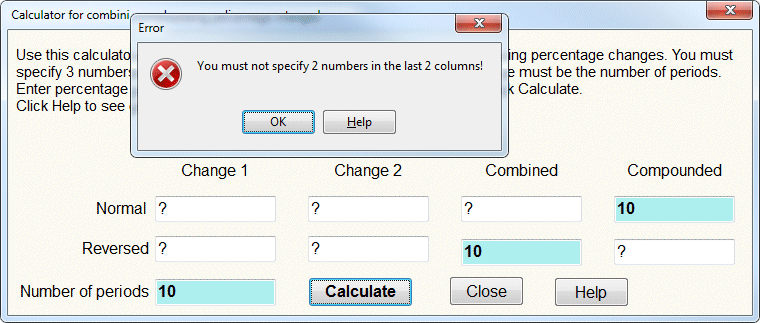Calculator for combining and compounding percentage changes
Under the View menu, you can find a calculator (pictured below) to compute the results of combining, compounding and reversing percentage changes. You must specify 3 numbers (marked with bold font and blue background); one of these must be the number of periods. Enter percentage change values into TWO of the other edit boxes. Then click Calculate - it uses the blue (bold-font) boxes to compute values for the white boxes. Pictures below show result after Calculate button is pressed.

Combining and compounding changes
Above picture shows the effects of combining 1% and 2% changes, giving 3.02%. Continued over 10 years, this would be a 34.65% increase.
Reversing a shock
Suppose we want to temporarily increase government spending by 20%. We see below that an initial 20% increase would later need to be reversed by a 16.67% decrease (100-->120-->100).

More compounding
Currently (2017), Melbourne's population is growing by 2.5% pa. If continued for 28 years, this would lead to a near doubling (see below, 99.65%) of population.

The calculation below answers the question: what rate of growth, continued for 20 years, would lead to a 100% increase? Answer: 3.53%

Inverse shocks
Technological change is often expressed by "A" variables which measure input-per-output -- so that a negative value represents progress! For example, if N = number of workers and A = workers per output, then the effective labour power is E = N/A.
Suppose the labour force grew by 2% pa, what shock to labour productivity is needed to increase labour's GDP contribution (E) by 5% pa? The calculation below shows that we must shock A by -2.857% pa.

Some CGE models express technological change in the opposite way: as output-per-input, or K=1/A. In such a model (eg, GTAP) we would need (see above) to shock K by 2.941%.
Restrictions
If you try to specify two numbers in the same column, or within the last two columns, you will get an error message like that below! Also, percent changes <-99% are disallowed (no changing sign!), and you cannot compound an 80% growth rate for 5000 years!

Calculating shocks without the calculator
For macro (scalar) shocks the calculator is very convenient -- but it will not help you calculate shock matrices. Instead, use a TABLO program to calculate shocks and write them to a HAR file. Often it is convenient to work in factors rather than percent changes. If p is the percent change then the corresponding factor F is (1+p/100). Then:
New = Old*F = Old* (1+p/100)
Example: what annual percent change over 8 years leads to a tripling?
p = 200 and so F = 3 (over 8 years). 3^(1/8) = 1.1472 so the required growth rate is 14.72% pa.
URL of this topic: www.copsmodels.com/webhelp/rundynam/hc_changecalc.htm
Link to full GEMPACK Manual
Link to GEMPACK homepage